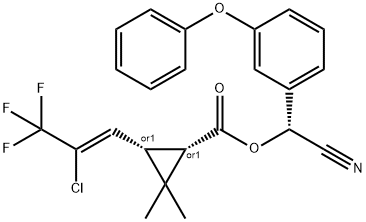Cyhalothrin is a broad-spectrum pesticide and acaricide that is used to control a wide range of pests in a variety of applications. It belongs to the pyrethroid, a class of synthetic insecticides which has the similar structure and insecticidal activity of the naturally occurring insecticide pyrethrum, derived from the flowers of chrysanthemums. It is commercially used for controlling insects on non-food crops, greenhouses, hospitals, and crops, such as cotton, cereals, hops, ornamentals, potatoes, vegetables, etc. and it targets various kinds of pests, including aphids, Colorado beetles and butterfly larvae. Besides, it is effective to used in public health applications to control insects identified as potential disease vectors, such as cockroaches, mosquitoes, ticks, and flies.
Registered with the EPA in 1988, Cyhalothrin is often preferred as an active ingredient in insecticides because it is proved to be mostly insoluble in water, which is an unlikely water contaminant. It is also nonvolatile, which makes it remain effective for extended periods of time.

